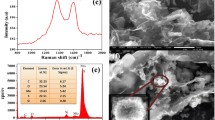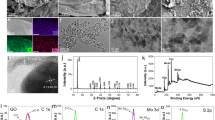Abstract
A fabrication strategy involving the electrostatic self-assembly of positively charged molybdenum disulfide (MoS2) nanosheets and negatively charged graphene oxide (GO) sheets and thermal reduction process is proposed to prepare MoS2/graphene hybrid films. The incorporation of MoS2 nanosheets embedded in graphene sheets serves as spacers, preventing the graphene sheets from restacking. The optimized free-standing MoS2/graphene hybrid film (MoS2/G-2) demonstrates a remarkable areal specific capacitance of 979 mF cm−2 at 1 mA cm−2, which is 2.85 times as much as pure reduced graphene oxide (rGO) (343 mF cm−2). Benefiting from the layer-layer self-assembly structure and good synergistic effect, MoS2/G-2 electrode exhibits enhanced capacitive performance with excellent cycling stability and no capacitance attenuation after 3000 cycles. Furthermore, by utilizing MoS2/G-2 as electrode material for the assembled symmetric supercapacitors (MoS2/G-2//MoS2/G-2), a superior areal energy density of 20 μWh cm−2 at the areal power density of 600 μW cm−2 is achieved. The prepared hybrid film materials hold immense potential in constructing high-performance film electrode for electrochemical energy storage.








Similar content being viewed by others
Data availability
All data included in this study are available upon request by contact with the corresponding author.
References
Qiu Z, Liu Z, Wang G, Huangfu C, Li Z, Yan Y, Chi C, Gao P, Lu X, Zhang S, Wei T, Fan Z (2023) Highly redox-active oligomers between graphene sheets as ultrahigh capacitance/rate and stable electrodes for supercapacitors. Energy Storage Mater 60:102824. https://doi.org/10.1016/j.ensm.2023.102824
El-Kady MF, Ihns M, Li M, Hwang JY, Mousavi MF, Chaney L, Lech AT, Kaner RB (2015) Engineering three-dimensional hybrid supercapacitors and microsupercapacitors for high-performance integrated energy storage. PNAS 112:4233–4238. https://doi.org/10.1073/pnas.1420398112
Zang X, Zhang R, Zhen Z, Lai W, Yang C, Kang F, Zhu H (2017) Flexible, temperature-tolerant supercapacitor based on hybrid carbon film electrodes. Nano Energy 40:224–232. https://doi.org/10.1016/j.nanoen.2017.08.026
Wang L, Han Y, Feng X, Zhou J, Qi P, Wang B (2016) Metal-organic frameworks for energy storage: batteries and supercapacitors. Coordin Chem Rev 307:361–381. https://doi.org/10.1016/j.ccr.2015.09.002
Inagaki M, Konno H, Tanaike O (2010) Carbon materials for electrochemical capacitors. J Power Sources 195:7880–7903. https://doi.org/10.1016/B978-0-12-407789-8.00011-9
Yu Z, Tetard L, Zhai L, Thomas J (2015) Supercapacitor electrode materials: nanostructures from 0 to 3 dimensions. Energy Environ Sci 8:702–730. https://doi.org/10.1039/c4ee03229
Muzaffar A, Ahamed MB, Deshmukh K, Thirumalai J (2019) A review on recent advances in hybrid supercapacitors: design, fabrication and applications. Renew Sust Energy Rev 101:123–145. https://doi.org/10.1016/j.rser.2018.10.026
Xu Y, Wang S, Peng H, Yang Z, Martin DJ, Bund A, Nanjundan AK, Yamauchi Y (2019) The interphase electrochemical characteristics of the cobaltosic oxide in organic electrolyte by Bode plots: double layer capacitance and pseudocapacitance. ChemElectroChem 6:2456–2463. https://doi.org/10.1002/celc.201900289
Han Y, Ge Y, Chao Y, Wang C, Wallace GG (2018) Recent progress in 2D materials for flexible supercapacitors. J Energy Chem 27:57–72. https://doi.org/10.1016/j.jechem.2017.10.033
Gandara M, Gonçalves ES (2020) Polyaniline supercapacitor electrode and carbon fiber graphene oxide: electroactive properties at the charging limit. Electrochim Acta 345:136197. https://doi.org/10.1016/j.electacta.2020.136197
Tian P, Zang J, Jia S, Zhang Y, Gao H, Zhou S, Wang W, Xu H, Wang Y (2018) Preparation of S/N co-doped graphene through a self-generated high gas pressure for high rate supercapacitor. Appl Surf Sci 456:781–788. https://doi.org/10.1016/j.apsusc.2018.06.213
Ye G, Gong Y, Lin J, Li B, He Y, Pantelides ST, Zhou W, Vajtai R, Ajayan PM (2016) Defects engineered monolayer MoS2 for improved hydrogen evolution reaction. Nano Lett 16:1097–1103. https://doi.org/10.1021/acs.nanolett.5b04331
Liu MC, Xu Y, Hu YX, Yang QQ, Kong LB, Liu WW, Niu WJ, Chueh YL (2018) Electrostatically charged MoS2/graphene oxide hybrid composites for excellent electrochemical energy storage devices. ACS Appl Mater Interfaces 10:35571–35579. https://doi.org/10.1021/acsami.8b09085
Zhang X, Zhang M, Tian Y, You J, Yang C, Su J, Li Y, Gao Y, Gu H (2018) In situ synthesis of MoS2/graphene nanosheets as free-standing and flexible electrode paper for high-efficiency hydrogen evolution reaction. RSC Adv 8:10698–10705. https://doi.org/10.1039/C8RA01226A
Liang J, Wang C, Zhao P, Wang Y, Ma L, Zhu G, Hu Y, Lu Z, Xu Z, Ma Y, Chen T, Tie Z, Liu J, Jin Z (2018) Interface engineering of anchored ultrathin TiO2/MoS2 heterolayers for highly-efficient electrochemical hydrogen production. ACS Appl Mater Interfaces 10:36084–36089. https://doi.org/10.1021/acsami.7b19009
Bello IT, Oladipo AO, Adedokun O, Dhlamini SM (2020) Recent advances on the preparation and electrochemical analysis of MoS2-based materials for supercapacitor applications: a mini-review. Mater Today Commun 25:101664. https://doi.org/10.1016/j.mtcomm.2020.101664
Gao YP, Huang KJ, Wu X, Hou ZQ, Liu YY (2018) MoS2 nanosheets assembling three-dimensional nanospheres for enhanced-performance supercapacitor. J Alloys Compd 741:174–181. https://doi.org/10.1016/j.jallcom.2018.01.110
Sarkar D, Das D, Das S, Kumar A, Patil S, Nanda KK, Sarma DD, Shukla A (2019) Expanding interlayer spacing in MoS2 for realizing an advanced supercapacitor. ACS Energy Lett 4:1602–1609. https://doi.org/10.1021/acsenergylett.9b00983
Huang KJ, Wang L, Liu YJ, Liu YM, Wang HB, Gan T, Wang LL (2013) Layered MoS2-graphene composites for supercapacitor applications with enhanced capacitive performance. Int J Hydrogen Energy 38:14027–14034. https://doi.org/10.1016/j.ijhydene.2013.08.112
Da Silveira Firmiano EG, Rabelo AC, Dalmaschio CJ, Pinheiro AN, Pereira EC, Schreiner WH, Leite ER (2014) Supercapacitor electrodes obtained by directly bonding 2D MoS2 on reduced graphene oxide. Adv Energy Mater 4:1–8. https://doi.org/10.1002/aenm.201301380
Bai LZ, Wang YH, Cheng SS, Li F, Zhang ZY, Liu YQ (2018) Synthesis and electrochemical performance of molybdenum disulfide-reduced graphene oxide-polyaniline ternary composites for supercapacitors. Front Chem 6:1–7. https://doi.org/10.3389/fchem.2018.00218
Thangappan R, Kalaiselvam S, Elayaperumal A, Jayavel R, Arivanandhan M, Karthikeyan R, Hayakawa Y (2016) Graphene decorated with MoS2 nanosheets: a synergetic energy storage composite electrode for supercapacitor applications. Dalton Trans 45:2637–2646. https://doi.org/10.1039/C5DT04832J
Jhankal D, Khan MS, Jhankal KK, Sachdev K (2023) Charge storage kinetics of MoS2 flower decorated reduced graphene oxide for quasi solid-state symmetric supercapacitor. J Phys Chem Solids 173:111117. https://doi.org/10.1016/j.jpcs.2022.111117
Bongu CS, Krishnan MR, Soliman A, Arsalan M, Alsharaeh EH (2023) Flexible and freestanding MoS2/graphene composite for high-performance supercapacitors. ACS Omega 8:36789–36800. https://doi.org/10.1021/acsomega.3c03370
Kumar P, Sharma S, Jabeen S, Samra KS (2022) Hybrid microwave annealing assisted synthesis of MoS2-RGO nanostructures: optimization and characterization for application in supercapacitors. Electrochim Acta 426:140738. https://doi.org/10.1016/j.electacta.2022.140738
Patil UM, Nam MS, Kang S, Sohn JS, Sim HB, Kang S, Jun SC (2016) Fabrication of ultra-high energy and power asymmetric supercapacitors based on hybrid 2D MoS2/graphene oxide composite electrodes: a binder-free approach. RSC Adv 6:43261–43271. https://doi.org/10.1039/C6RA00670A
Yang X, Niu H, Jiang H, Wang Q, Qu F (2016) High energy density all-solid-state asymmetric supercapacitor based on MoS2/graphene nanosheet and MnO2/graphene hybrid electrodes. J Mater Chem A 4:11264–11275. https://doi.org/10.1039/C6TA03474H
Saraf M, Natarajan K, Mobin SM (2018) An emerging robust heterostructure of MoS2-rGO for high-performance supercapacitors. ACS Appl Mater Interfaces 10:16588–16595. https://doi.org/10.1021/acsami.8b04540
Joseph N, Muhammed Shafi P, Bose AC (2020) Recent advances in 2D-MoS2 and its composite nanostructures for supercapacitor electrode application. Energy Fuels 34:6558–6597. https://doi.org/10.1021/acs.energyfuels.0c0043
Ansari SA, Fouad H, Ansari SG, Sk MP, Cho MH (2017) Mechanically exfoliated MoS2 sheet coupled with conductive polyaniline as a superior supercapacitor electrode material. J Colloid Interface Sci 504:276–282. https://doi.org/10.1016/j.jcis.2017.05.064
Du X, Shi X, Li Y, Cao K (2020) Construction of N, S-co-doped graphene/polyaniline composite as free-standing electrode material. Int J Energy Res 45:6227–6238. https://doi.org/10.1002/er.6243
Zhou C, Hong M, Yang Y, Yang C, Hu N, Zhang L, Yang Z, Zhang Y (2019) Laser-induced bi-metal sulfide/graphene nanoribbon hybrid frameworks for high-performance all-in-one fiber supercapacitors. J Power Sources 438:227044. https://doi.org/10.1016/j.jpowsour.2019.227044
Chang Y, Shi H, Yan X, Zhang G, Chen L (2020) A ternary B, N, P-Doped carbon material with suppressed water splitting activity for high-energy aqueous supercapacitors. Carbon 170:127–136. https://doi.org/10.1016/j.carbon.2020.08.013
Zhou Y, Wang X, Acauan L, Kalfon-Cohen E, Ni X, Stein Y, Gleason KK, Wardle BL (2019) Ultrahigh-areal-capacitance flexible supercapacitor electrodes enabled by conformal P3MT on horizontally aligned carbon-nanotube arrays. Adv Mater 31:1901916. https://doi.org/10.1002/adma.201901916
Choi SH, Kang YC (2015) Polystyrene-templated aerosol synthesis of MoS2-amorphous carbon composite with open macropores as battery electrode. ChemSusChem 8:2260–2267. https://doi.org/10.1002/cssc.201500063
David L, Bhandavat R, Singh G (2014) MoS2/graphene composite paper for sodium-ion battery electrodes. ACS Nano 8:1759–1770. https://doi.org/10.1021/nn406156b
Gołasa K, Grzeszczyk M, Bożek R, Leszczyński P, Wysmołek A, Potemski M, Babiński A (2014) Resonant Raman scattering in MoS2-from bulk to monolayer. Solid State Commun 197:53–56. https://doi.org/10.1016/j.ssc.2014.08.009
Cao Y (2021) Roadmap and direction towards high performance MoS2 hydrogen evolution catalysts. ACS Nano 15:11014–11039. https://doi.org/10.1021/acsnano.1c01879
Wang N, Pan Q, Yang X, Zhu H, Ding G, Jia Z, Wu Y, Zhao L (2019) High performance asymmetric supercapacitor based on NixSy/MoS2 nanoparticles. ACS Appl Nano Mater 2:4910–4920. https://doi.org/10.1021/acsanm.9b00874
Zeng R, Li Z, Li L, Li Y, Huang J, Xiao Y, Yuan K, Chen Y (2019) Covalent connection of polyaniline with MoS2 nanosheets toward ultrahigh rate capability supercapacitors. ACS Sustainable Chem Eng 7:11540–11549. https://doi.org/10.1021/acssuschemeng.9b01442
He C, Liang Y, Gao P, Long C, Shi D, Xie X, Li RK-Y, Yang Y (2017) Bioinspired Co3O4 /graphene layered composite films as self-supported electrodes for supercapacitors. Compos Part B 121:68–74. https://doi.org/10.1016/j.compositesb.2017.03.025
Masikhwa TM, Madito MJ, Bello A, Dangbegnon JK, Manyala N (2017) High performance asymmetric supercapacitor based on molybdenum disulphide/graphene foam and activated carbon from expanded graphite. J Colloid Interf Sci 488:155–165. https://doi.org/10.1016/j.jcis.2016.10.095
Zhuo Y, Prestat E, Kinloch IA, Bissett MA (2022) Self-assembled 1T-MoS2/functionalized graphene composite electrodes for supercapacitor devices. ACS Appl Energy Mater 5:61–70. https://doi.org/10.1021/acsaem.1c02203
Yan J, Ren CE, Maleski K, Hatter CB, Anasori B, Urbankowski P, Sarycheva A, Gogotsi Y (2017) Flexible Mxene/graphene films for ultrafast supercapacitors with outstanding volumetric capacitance. Adv Funct Mater 27:1701264. https://doi.org/10.1002/adfm.201701264
Zheng F, Wei Z, Xia H, Tu Y, Meng X, Zhu K, Zhao J, Zhu Y, Zhang J, Yang Y, Deng D (2022) 3D MoS2 foam integrated with carbon paper as binder-free anode for high performance sodium-ion batteries. J Energy Chem 65:26–33. https://doi.org/10.1016/j.jechem.2021.05.021
Sarmah D, Kumar A (2021) Symmetric supercapacitors with layer-by-layer Molybdenum disulfide-reduced graphene oxide structures and poly(3,4-ethylenedioxythiophene) nanoparticles nanohybrid electrode. J Energy Storage 35:102289. https://doi.org/10.1016/j.est.2021.102289
Zhang C, Ning J, Wang B, Guo H, Feng X, Shen X, Jia Y, Dong J, Wang D, Zhang J, Hao Y (2021) Hybridized 1T/2H-MoS2/graphene fishnet tube for high-performance on-chip integrated micro-systems comprising supercapacitors and gas sensors. Nano Res 14:114–121. https://doi.org/10.1007/s12274-020-3052-x
Tang M, Wu Y, Yang J, Xue Y (2020) Hierarchical core-shell fibers of graphene fiber/radially-aligned molybdenum disulfide nanosheet arrays for highly efficient energy storage. J Alloys Compd 828:153622. https://doi.org/10.1016/j.jallcom.2019.153622
Zhou Q, Lv G, Wang X, Teng W, Hu P, Du Y, Li H, Hu Y, Liu W, Wang J (2023) Constructing a hierarchical ternary hybrid of PEDOT:PSS/rGO/MoS2 as an efficient electrode for a flexible fiber-shaped supercapacitor. ACS Appl Energy Mater 6:5797–5805. https://doi.org/10.1021/acsaem.3c00187
Zhang Z, Xiao F, Wang S (2015) Hierarchically structured MnO2/graphene/carbon fiber and porous graphene hydrogel wrapped copper wire for fiber-based flexible all-solid-state asymmetric supercapacitors. J Mater Chem A 3:11215–11223. https://doi.org/10.1039/c5ta02331a
Wang B, Fang X, Sun H, He S, Ren J, Zhang Y, Peng H (2015) Fabricating continuous supercapacitor fibers with high performances by integrating all building materials and steps into one process. Adv Mater 27:7854–7860. https://doi.org/10.1002/adma.201503441
Acknowledgements
This work was supported by the Key Scientific Research Project in Colleges and Universities of Henan Province of China (No. 22B430024) and the Science and Technology Development Program of Henan province of China (No. 222102320057).
Author information
Authors and Affiliations
Corresponding author
Ethics declarations
Competing interests
The authors declare that they have no known competing financial interests or personal relationships that could have appeared to influence the work reported in this paper.
Additional information
Publisher’s note
Springer Nature remains neutral with regard to jurisdictional claims in published maps and institutional affiliations.
Rights and permissions
Springer Nature or its licensor (e.g. a society or other partner) holds exclusive rights to this article under a publishing agreement with the author(s) or other rightsholder(s); author self-archiving of the accepted manuscript version of this article is solely governed by the terms of such publishing agreement and applicable law.
About this article
Cite this article
Du, X., Liu, S., Zhou, Y. et al. Electrostatic self-assembly of MoS2/graphene hybrid films for energy storage in high-performance symmetric supercapacitor. Ionics (2024). https://doi.org/10.1007/s11581-024-05544-y
Received:
Revised:
Accepted:
Published:
DOI: https://doi.org/10.1007/s11581-024-05544-y




